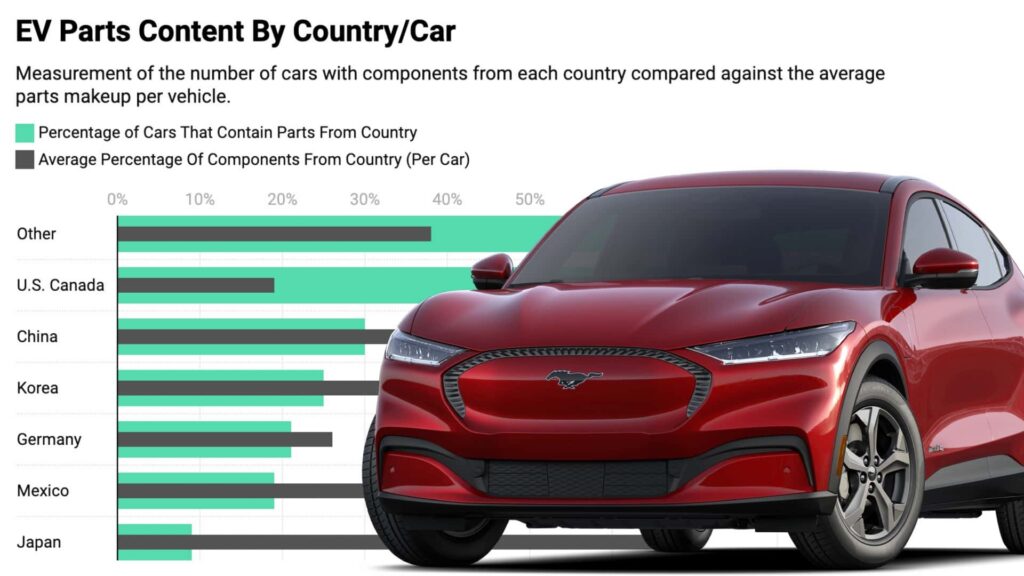In the case of electric vehicles (EVs), this data reveals some surprising truths. Despite the push for more American-made products, it turns out that even the most “American” EVs are not completely made in America. In fact, about half of all EVs have 10% or fewer components that are sourced from the U.S. and Canada.
With the recent implementation of 25% auto tariffs by the Trump administration, the EV market in the U.S. is facing higher production costs and potentially higher prices for consumers. This includes all EVs, from those assembled in China to Hyundais assembled in Georgia.
The idea of a car being “Made in America” has become more complicated in today’s global economy. Automakers rely on a network of suppliers from around the world to source parts for their vehicles. While final assembly may take place in the U.S., many of the components come from overseas.
This reliance on global suppliers has now become a major issue with the new tariffs in place. Every single EV for sale in the U.S. will be impacted, regardless of where it was assembled. The supply chain for EVs is complex, with parts coming from various countries to be assembled in the final product.
Looking at the data from the American Automobile Labeling Act, it’s clear that the majority of EVs have components sourced from outside of the U.S. This means that even vehicles that are assembled domestically still rely on international suppliers for parts.
As the EV market continues to grow and evolve, the impact of tariffs and trade policies will be an important factor to consider. The push for more sustainable transportation options must also take into account the global nature of the automotive industry. Ultimately, the goal is to create a more sustainable and environmentally friendly transportation system, but this will require navigating the complexities of global trade and tariffs. Canada, known for its strict emissions regulations and commitment to preserving the environment, has been at the forefront of the electric vehicle (EV) movement. However, recent changes in incentives and tariffs have put Canada in direct competition with other major players in the EV market, such as China, Germany, and the United States.
One key aspect that determines the competitiveness of EVs in different markets is the final assembly location. In Canada, only 28 out of the 67 BEVs listed on the NHTSA’s dataset are assembled domestically. This number pales in comparison to China and Germany, where a larger percentage of EVs are produced locally. This difference in final assembly location can have significant implications on import tariffs and incentives, giving an advantage to countries with more domestic production.
In terms of parts content, Canada faces stiff competition from countries like the U.S. and China. About half of the EVs listed have less than 10% of parts derived from the U.S. and Canada, with some vehicles even having 0% parts content from these countries. This can lead to higher costs for manufacturers and consumers, making it challenging for Canadian EVs to compete on a global scale.
On the other hand, EVs with higher U.S. and Canada parts content, such as the Tesla Model 3, Model Y, and Volkswagen ID.4, have a competitive edge in the market. These vehicles benefit from lower import tariffs and incentives, making them more attractive to consumers.
Overall, Canada’s position in the global EV market is influenced by factors such as final assembly location and parts content. While the country has made significant strides in promoting electric mobility, it faces tough competition from other countries with more established EV industries. To remain competitive, Canada will need to continue investing in domestic production and innovation to meet the growing demand for electric vehicles worldwide. The latest data from the National Highway Traffic Safety Administration (NHTSA) has revealed some concerning information about the electric vehicles (EVs) currently on U.S. roads. According to the data, Tesla’s Model 3 has the highest rate of range loss among all EVs, with a decrease of 10% after 100,000 miles of driving. Every other vehicle on the list is at 62% or below.
However, it’s important to note that the NHTSA data does not include some EVs currently on U.S. roads. General Motors was unable to provide data for the Cadillac Lyriq, Optiq, and Vistiq. Similarly, Rivian, Faraday Future, Lucid Motors, Maserati, and VinFast did not respond to requests for this information at the time of writing.
With this concerning data in mind, the biggest question on everyone’s mind is how this will affect consumers. One significant impact is expected to be on new car buyers, as new vehicle prices are expected to increase significantly due to these tariffs. While the exact amount of the price increase is uncertain, analysts predict that new car prices could rise between 11% and 12%.
Morgan Stanley predicts that new car prices could increase between 11% and 12%, even for domestically produced vehicles. The Anderson Economic Group predicts that vehicle costs could rise anywhere from $2,500 to over $20,000, with larger SUVs, luxury vehicles, and sports cars facing the highest price hikes.
The potential increase in vehicle costs could lead to a contraction of the new car market by 15% to 20%, depending on how automakers decide to handle the tariffs. Additionally, even consumers who are not in the market for a new car may feel the impact, as the expected loss per household could range from $450 to $500 at the lowest income bracket due to the ripple effect on the economy.
While automakers may try to reduce their costs to mitigate the impact of tariffs, the reality is that major changes to production lines and supply chains cannot happen overnight. As a result, consumers may have to brace themselves for higher prices on vehicles and related goods and services in the near future. The digital age has revolutionized the way we communicate, work, and live our daily lives. With the rise of social media, smartphones, and the internet, we are more connected than ever before. However, this increased connectivity has also come with its own set of challenges, including the rise of cyberbullying.
Cyberbullying is a form of bullying that takes place online, typically through social media platforms, messaging apps, or online gaming. It can take many forms, including sending hurtful messages, spreading rumors, sharing embarrassing photos or videos, and even creating fake profiles to harass someone.
One of the most troubling aspects of cyberbullying is that it can happen 24/7, with victims feeling like they have no escape from the harassment. This constant barrage of negative messages can have a serious impact on a person’s mental health, leading to feelings of depression, anxiety, and even thoughts of self-harm or suicide.
Another concerning aspect of cyberbullying is the anonymity it provides to perpetrators. Behind the safety of a screen, bullies feel emboldened to say things they would never say in person. This can make it difficult for victims to identify their tormentors and seek help.
Fortunately, steps are being taken to address the issue of cyberbullying. Many social media platforms have implemented reporting tools and algorithms to detect and remove harmful content. Schools are also taking a proactive approach, educating students about the dangers of cyberbullying and encouraging them to speak up if they or someone they know is being targeted.
Parents also play a crucial role in preventing cyberbullying. By monitoring their children’s online activity, setting boundaries around screen time, and having open and honest conversations about digital safety, parents can help protect their children from becoming victims or perpetrators of cyberbullying.
Ultimately, addressing the issue of cyberbullying requires a collective effort from schools, parents, social media platforms, and the wider community. By raising awareness, providing support to victims, and holding bullies accountable for their actions, we can work towards creating a safer and more respectful online environment for everyone.

